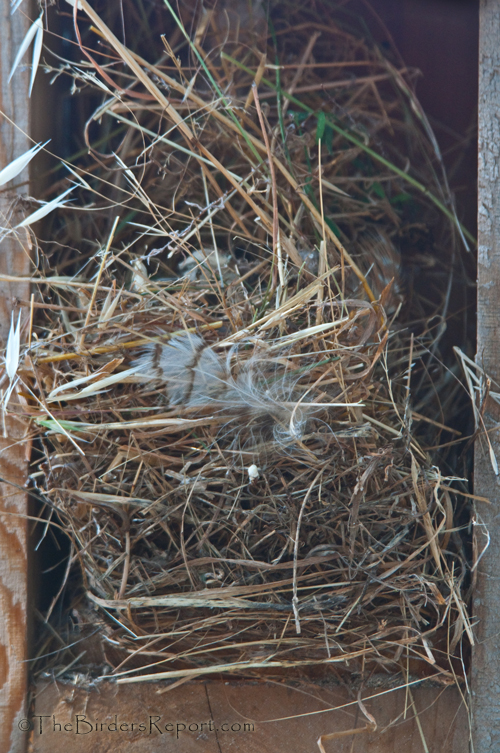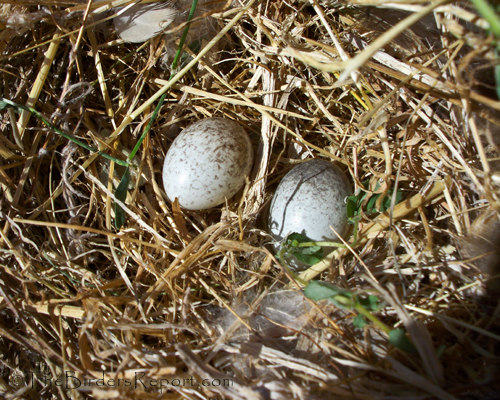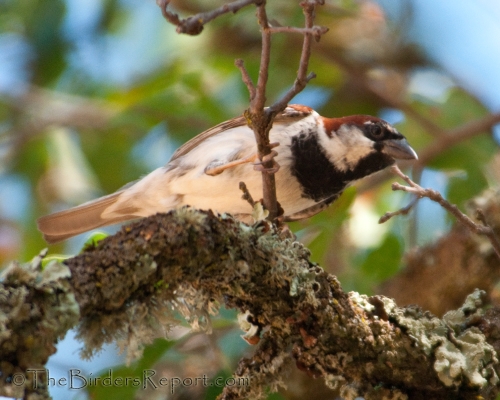Male House Sparrow photos by Larry Jordan
As I made what I thought would be my last nest box monitoring walk through Palo Cedro Community Park this afternoon, the House Sparrow eyeballing me from a branch above confirmed my nest and egg identification. My nest box had been taken over by House Sparrows! This will never do!
When I opened what I thought would be an empty Western Bluebird nest box, I found this.

A jumble of grass and weeds filling the box, making a tunnel to the entrance hole. I pulled it out of the box and looked into the deep cup. House Sparrow eggs.

These eggs can vary immensely from one bird to another and even from the same bird. One of these eggs had brown markings and the other had dark gray markings. You can see more examples of the House Sparrow nest and eggs on my Egg and Nest Identification page.
House Sparrows are a non-native, invasive species in North America and are not protected by law. They will take over nest boxes and chase off or kill native birds. There are several things you can do to protect your nest boxes against this invader. For extensive information on this subject, please visit my friend Bet Zimmerman’s Page.
These birds are native to Europe where they are having a marked decline in numbers. You can read about the European problem at the British Trust for Ornithology website. On the other hand, unfortunately, they are not on the decline here in the U.S. You can read about their history at Bet’s website here.
I will have to monitor this nest box, removing the eggs as I find them, until the House Sparrows leave. Once the male takes over a birdhouse, he won’t give it up. For this reason alone, it is important to never let them nest in your birdhouses and make sure you never allow them to actually hatch any eggs.
On a more positive note, my nest box fledging numbers for the 2010 season are as follows:
- Oak Titmouse (OATI) – 32
- Western Bluebird (WEBL) – 52
- Tree Swallow (TRES) – 19
- Ash-throated Flycatcher (ATFL) – 8
- Violet-green Swallow (VGSW) – 4
The four letter abbreviations are the “Alpha” codes used by ornithologists to reflect American Ornithologists’ Union (AOU) taxonomy and nomenclature for North American birds. You can download a copy of it here. I found it at The Institute For Bird Populations. They do some wonderful work studying bird populations, including work on our friend, the Burrowing Owl.
I want to make it clear, as Andy states in his comment below, that disturbing a bird’s nest is illegal in the United States for any native species. Native species are protected by the Migratory Bird Treaty Act, but non-native species are not. Therefore, the removal of a House Sparrow or European Starling nest would be legal in the U.S. but not legal in the UK or in Europe where they are a declining native species.










Comments on this entry are closed.
Please allow me to clarify: your advice about deterring House Sparrows applies in the USA, where they’re an invasive species. Here in the UK, where they’re native and declining, it would be illegal to do as you suggest.
An interesting perspective on House Sparrows in the US Larry. You righly say they are in decline here in the UK where the BTO now like us to catch and band as many as possible to investigate reasons for their downturn. How bird fortunes vary?
.-= Phil´s last blog ..A Little Lunch =-.
Howdee Larry,
yeah these sure are pesky critters…its a bit overwhelming here lately..tons of house sparrows..i stop feeding the birds for a few days till the go elsewhere..then start again..
on and off..just to get them going somewhere else.
I dont know if you are aware of it..
Fatbirders top 1000 site has recently been attacked and there is malware associated with the site.
birdchick and others have take off the of the counter until things are good again.
I took mine off as well. I had a few people saying they got a warning about my site.
hope all is well..
have a nice rest of the summer.
.-= Dawn Fine´s last blog ..My Small Garden- Ledyard-CT =-.
@Andy thank you very much for your clarification. I have added a paragraph that should make this perfectly clear.
@Phil it is a dichotomy. We have been overwhelmed by many non-native species in the U.S. (not only birds) as the same species decline elsewhere, where they are native.
Larry: Thank you.
.-= Andy Mabbett´s last blog ..Google Maps’ microformats- unhappy anniversary – still broken after three years =-.
what birds make nests in the hederows because when i was about to cut the hedge, i found 5 nests that had been used but no eggs to help
@Lowback there are many birds that nest in hedgerows! It is a very long list which includes, Mockingbirds, American Robins, some sparrows, buntings, and warblers. The list goes on and on.